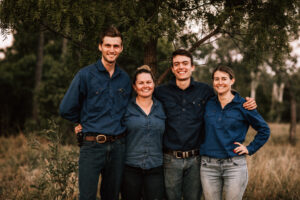Carbon and environmental markets for beef producers: Method to Market project update
The Method to Market project operating in central and south-west Queensland is investigating opportunities for extensive grazing businesses to engage in environmental and carbon markets.
Initially, emission baselines were calculated for the eight businesses involved. Determining an accurate emission baseline requires consolidated herd data which was highlighted as a significant barrier to most businesses. As expected, enteric methane emissions were identified as the greatest contributor to each businesses emission profile. The most economical pathways currently available to producers to reduce this emission source is to improve herd productivity. This approach decreases emission intensity (green-house gas emissions per kilogram of beef produced), and has significant financial rewards from increasing beef production per animal. Methods of achieving this are all covered in grazing best management practices (BMPs), specifically those BMPs that improve weaning rate and increase weight gains. It should be noted that emission reductions achieved through this method will not be sufficient to achieve carbon neutrality.
Carbon offsets were also investigated for their viability in grazing systems. The focus was on vegetation-based sequestration however soil carbon opportunities were also identified. Most of the research to date demonstrates the high degree of variability due to seasonal changes associated with soil carbon and the marginal impact land management has on carbon fractions. This combined with the high overhead costs required to calculate a baseline and measure soil carbon change renders this method non-viable to most graziers in rangeland systems. Projects with the most potential are in areas that have experienced significant management change such as transitioning from a highly tilled area under cropping to permanent pastures.
Vegetation projects were the easiest and offered the greatest short-term rewards. As a method of sequestering carbon, vegetation is easily measured and modelled and requires little practise change, particularly in northern Australia where regrowth is often vigorous. The return of grazing land to vegetation typically reduces carrying capacity and therefore productivity. This loss can be compensated by acquiring carbon credits (ACCUs) however, the economic viability is driven by:
- The productivity of the land under grazing
- The volume of carbon stored in the typical vegetation density of the land
- The market value of carbon credits, and
- The market value of the grazing animal.
The carbon market position throughout the project has demonstrated that carbon projects outperform grazing over the typical project lifetime of 25 years. As soil and vegetation-based carbon sinks are limited in their sequestration capacity, the carbon projects assessed within this project would not produce carbon credits beyond 25 years. This means that, when analysed in perpetuity, the returns were comparable in most of the land types on properties involved in the analysis however there is likely to be “break-even” regions based on land type and rainfall which fit the criteria above. In addition to reducing productivity, the effect on land value was significant which consistently favoured livestock production over carbon projects in an economic sense.
Issues arise in achieving economic viability through selling carbon credits as, once sold, the carbon credit acquired cannot be lodged against the business’s own emissions. So, a producer who is striving to reach carbon neutrality would need to acquire carbon credits, through purchasing or developing a carbon project, and lodge them against their own business’s emissions rather than sell them. Obtaining carbon neutrality has an economic cost whether it is through lost production or the cost of the credits used to offset emissions. Currently, there are no market premiums that offset this cost and do not yet economically incentivise a carbon neutral product.
Environmental credits are similarly restricted in their economic viability. Biodiversity is particularly difficult to measure and it is expensive to verify baselines and improvements. Currently, environmental accounts are incentivised through government grants or policy driven offsets. There are no frameworks at an industry scale that offset measurement costs for environmental stewardship on farm through market premiums or other similar economic advantages.
With the end of the project approaching, the Method to Market team is developing case studies that demonstrate emission baselining and carbon and environmental opportunities from a production and economic standpoint. The aim is to provide a greater understanding of the challenges and viability of projects for producers looking to develop carbon and natural capital accounts.
For more information about the Method to Market project please contact Josh Peart.
